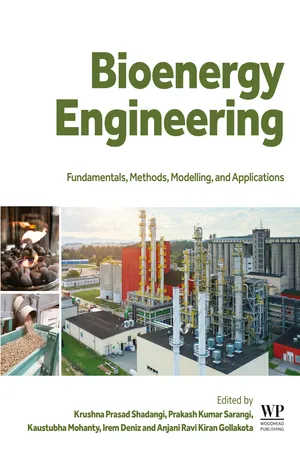
Bioenergy Engineering
Fundamentals, Methods, Modelling, and Applications
- 586 pages
- English
- ePUB (mobile friendly)
- Available on iOS & Android
Bioenergy Engineering
Fundamentals, Methods, Modelling, and Applications
About This Book
Bioenergy Engineering: Fundamentals, Methods, Modelling, and Applications presents the fundamental principles, recent developments, innovative state-of the-art technologies, challenges, solutions and future perspectives on the production of biofuels and bioenergy. Balancing the scientific and engineering aspects of biofuels production, the book guides readers through the chemical kinetics, modeling, thermodynamics, unit operations and technological advancements in fuel processing from conventional and alternative resources. Each chapter of the book starts with the fundamentals and goes on to assess the latest technologies for the production of renewable fuels on topics.
Sections cover biomass utilization, biomass-to-liquid conversion technologies (pyrolysis, liquefaction, solid-state fermentation and submerged fermentation), biomass-to-gas conversion technologies (thermochemical gasification, subcritical and supercritical water gasification, and methanation), gas-to-liquid conversion technologies (Fischer-Tropsch synthesis), carbonization, transesterification, organic transformation, carbon-carbon and carbon-heteroatom coupling reactions, oxidation, reforming, hydrotreating technologies (hydrogenation, hydrodesulfurization, hydrodenitrogenation, hydro dearomatization and hydro demetalization), nanocatalysis and biocatalysis (enzymatic hydrolysis), and much more.
- Analyzes emerging technologies for the sustainable conversion of various waste and non-waste materials into bioenergy and biofuels
- Examines a wide range of feedstocks and conversion pathways for liquid and gaseous biofuels
- Offers practical guidance and data on how to conduct lifecycle assessment, techno-economic analysis, and utilize GIS modeling for a range production pathways
Frequently asked questions
Information
Table of contents
- Cover image
- Title page
- Table of Contents
- Copyright
- List of contributors
- Chapter 1. Introduction to bioenergy; current status, merits & demerits
- Chapter 2. Feedstock for biofuel production: starch, oilseeds, lignocellulosic and algae-based, fuel logistics of biomass
- Chapter 3. Characterization techniques of biomass: physico-chemical, elemental, and biological
- Chapter 4. Comparisons between fossil fuels and bio-fuels
- Chapter 5. Agricultural waste to fuels and chemicals
- Chapter 6. Cogasification of biomass and coal for the production of biofuels
- Chapter 7. Role of catalysts in biofuel production through fast pyrolysis
- Chapter 8. Advances in gasification techniques
- Chapter 9. Thermal energy storage materials from triglycerides
- Chapter 10. Biological conversion technologies: Enzyme hydrolysis, ethanol fermentation
- Chapter 11. Anaerobic digestion methods for the production of fuels
- Chapter 12. Microbial fuel cells
- Chapter 13. Sustainable energy from food waste via using a sustainable microbial system
- Chapter 14. Algal biofuel and its prospects
- Chapter 15. High-value–added products from microalgae production integrated with bioethanol process
- Chapter 16. Bright-skies to biomass fuels in aviation sector
- Chapter 17. Biohydrogen production by biological water-gas shift reaction and bioelectrochemical systems
- Chapter 18. Methods of catalyst synthesis and recycling processes for biofuel upgradation
- Chapter 19. Biocatalysts for biofuels production
- Chapter 20. Microwave assisted catalysis for biofuel production
- Chapter 21. Alcoholic fuels from food waste in restaurants
- Chapter 22. Bioenergy engineering: fundamentals, methods, modeling, and applications: Mathematical modeling of biomass gasification processes
- Chapter 23. Hydro-deoxygenation of biofuel
- Chapter 24. Economic, social and ecological impacts of bioenergy at local, national and global levels
- Chapter 25. Life cycle assessment of biofuels
- Index